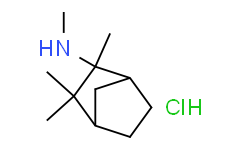| Cas No.: | 826-39-1 |
| Chemical Name: | Mecamylamine hydrochloride |
| Synonyms: | Mecamylamine hydrochloride;2-(Methylamino)isocamphane hydrochloride;Inversine;N,2,3,3-Tetramethylbicyclo[2.2.1]heptan-2-amine hydrochloride;Mecamylamine (hydrochloride);Mecamylamine Hcl;Mecamylamine Hydroch;N,2,2,3-tetramethylbicyclo[2.2.1]heptan-3-amine,hydrochloride;MECAMYLAMINE USP |
| SMILES: | Cl.CNC1(C2CCC(C2)C1(C)C)C |
| Formula: | C11H22ClN |
| M.Wt: | 203.75208234787 |
| Purity: | >98% |
| Sotrage: | 2 years -20°C Powder, 2 weeks 4°C in DMSO, 6 months -80°C in DMSO |
| Description: | Mecamylamine hydrochloride is an orally active, nonselective, noncompetitive nAChR antagonist that can treat various neuropsychiatric disorders. Mecamylamine hydrochloride is originally used as a ganglionic blocker in treating hypertension. Mecamylamine hydrochloride can easily crosses the blood-brain barrier[1][2]. |
| Target: | nAChR[1] |
| In Vivo: | Mecamylamine (0.5-1 mg/kg; Intraperitoneal injection; C57BL/6J mice) has antidepressant-like effects in both the TST and FST and these effects are dependent on bothβ2 andα7 subunits[3]. Animal Model: C57BL/6J mice (3-4 months) forced swim test (FST) and tail suspension test (TST)[3] Dosage: 0.5 mg/kg, 0.75 mg/kg, 1 mg/kg Administration: Intraperitoneal injection Result: Significantly decreased immobility time in the TST at the 1.0-mg/kg dose but did not alter baseline locomotor activity. Also significantly decreased time immobile in the FST. |
| In Vitro: | Mecamylamine blocks muscle nAChRs in a use- and voltagedependent manner. Mecamylamine blocks the nicotinic currents via trapping mechanism. The main feature of this block is the phenomenon of block relief, which might be revealed by combined action of depolarization and activation of nAChRs. The experimental study of the Mecamylamine action on muscle nAChRs revealed that: (1) Mecamylamine (1-20 μM) reduces evoked end-plate currents (EPC) amplitude with Hill’s constant equal to 1.2 and IC50 = 7.8 μM at holding potential –70 mV; (2) the calculated depth of its interaction with the muscle nAChR channel is almost half of the one of neuronal nAChRs (0.37 compare to 0.72 for neuronal nAChRs); (3) simultaneous membrane depolarization and repetitive activation of postsynaptic nAChRs by motor nerve stimulation produced rapid block relief dependent on the degree of depolarization, number of conditioning signals and Mecamylamine concentration, and only slightly depended on the rate of stimulation[2]. |
| References: | [1]. Bacher I, et al. Mecamylamine - a nicotinic acetylcholine receptor antagonist with potential for the treatment of neuropsychiatric disorders. Expert Opin Pharmacother. 2009 Nov;10(16):2709-21. [2]. Ostroumov K, et al. Modeling study of mecamylamine block of muscle type acetylcholine receptors. Eur Biophys J. 2008 Apr;37(4):393-402. [3]. Rabenstein RL, et al. The nicotinic antagonist mecamylamine has antidepressant-like effects in wild-type but not beta2- or alpha7-nicotinic acetylcholine receptor subunit knockout mice. Psychopharmacology (Berl). 2006 Dec;189(3):395-401. |

 To enhance service speed and avoid tariff delays, we've opened a US warehouse. All US orders ship directly from our US facility.
To enhance service speed and avoid tariff delays, we've opened a US warehouse. All US orders ship directly from our US facility.




















